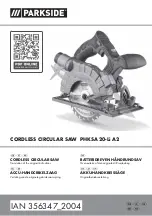
21
ENGLISH
3.
Attach the other hexagon head
screws likewise to the right-hand
side of the right front leg.
6.1
Mains connection
B
Danger! Electrical hazard.
Operate saw in dry environ-
ment only.
Operate saw only on a power source
matching the following requirements
(see also "Technical specifications"):
−
Outlets properly installed,
earthed and tested.
−
Three-phase outlets with neutral
wire.
−
Mains voltage and system fre-
quency conform to the voltage
and frequency shown on the
machine's rating label.
−
Protection against electric shock
by a residual current device
(RCD) of 30 mA sensivity.
−
Fuse protection of 16 A maximum
against short circuits.
−
System impedance Z
max.
at the
interconnection point (house
service connection) 0.35 Ohm
maximum.
3
Note:
Check with your local Electricity
Board or electrician if in doubt whether
your house service connection meets
these requirements.
Position power supply cable so it
does not interfere with the work and
is not damaged.
Protect power supply cable from heat,
aggressive liquids and sharp edges.
Use only rubber-jacketed extension
cables with sufficient lead cross-sec-
tion (see "Technical specifications").
Do not pull on power supply cable to
unplug.
B
Changing the direction of rota-
tion! (three-phase motors only)
Depending on the phase
sequence, it is possible the
saw blade will turn in the
wrong direction. This can lead
to the workpiece being hurled
away when attempting to make
a cut. The direction of rotation
must therefore be check every
time the saw is connected to
another outlet. In case of an
incorrect direction of rotation,
the wiring of the outlet must be
changed by a qualified electri-
cian:
1.
After the saw and all of its safety
devices have been assembled, con-
nect it to the mains supply.
2.
Raise saw blade fully.
3.
Start saw and switch OFF immedi-
ately.
4.
Check the saw blade's direction of
rotation from the left-hand side of
the saw. The saw blade must rotate
clockwise.
5.
If the saw blade rotates counter-
clockwise, unplug the power cable
at the saw.
6.
Have the electric supply changed by
a qualified electrician!
6.2
Installation
•
Place the machine on a firm, level
floor.
•
Ensure there is sufficient space to
handle larger workpieces.
For maximum upright stability the saw
can be bolted to the floor:
1.
Place the fully assembled saw at a
suitable site and mark the bore
holes on the floor.
2.
Move saw aside and drill the holes.
3.
Align saw with the holes and bolt to
the floor.
A
Risk of injury!
This saw may only be operated
by one person at a time. Other per-
sons shall stay only at a distance to
the saw for the purpose of feeding or
removing stock.
Before starting work, check to see
that the following are in proper work-
ing order:
−
power cable and plug;
−
ON/OFF switch
−
riving knife
−
blade guard
−
feeding aids (push stick, push
block and handle).
Use personal protection gear:
−
dust respirator;
−
hearing protection;
−
safety goggles.
Assume proper operating position:
−
at the front of the saw;
−
in front of the saw;
−
to the left of the line of cut;
−
when working with two persons,
the other person must remain at
an adequate distance to the saw.
If the type of work requires, use the
following:
−
table extension, if otherwise
workpiece would fall off the table
after cutting;
−
sliding carriage;
−
dust collector.
Avoid typical operator mistakes:
−
Do not attempt to stop the saw
blade by pushing the workpiece
against its side. Risk of kickback.
−
Always hold the workpiece down
on the table and do not jam it.
Risk of kickback.
−
Never cut several workpieces at
the same time – and also no bun-
dles containing several individual
pieces. Risk of personal injury if
individual pieces are caught by
the saw blade uncontrolled.
c
Drawing-in/trapping hazard!
Never cut stock to which
ropes, cords, strings, cables or wires
are attached or which contain such
materials.
7.1
Dust collector
A
Danger!
Dust of certain timber species
(e.g. beech, oak, ash) can cause can-
cer when inhaled. Use a suitable dust
collector when working in enclosed
spaces The dust collector must meet
the following requirements:
−
hoses must fit the outer diameter
of the dust extraction ports (blade
guard 36 mm; chip case 100 mm);
−
air flow volume
≥
460 m
3
/h;
−
vacuum at dust extraction port of
saw
≥
530 Pa;
−
air speed at dust extraction port
of saw
≥
20 m/ s.
The dust extraction ports are located at
the chip case assembly and at the saw
blade guard.
Observe the dust collector's operating
instructions as well!
65
7.
Operation
Содержание TKHS 315 E/P 2.2 W
Страница 62: ...62 X_1Leer fm ...
Страница 64: ...ZINDEL Technische Dokumentation und Multimedia www zindel de U4BA_EB2 fm ...
















































